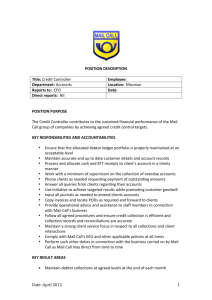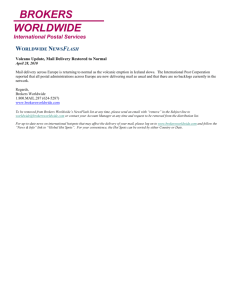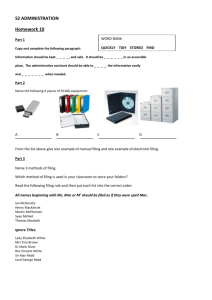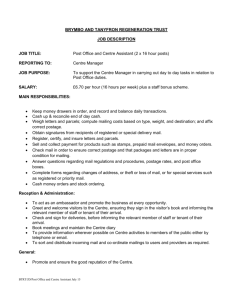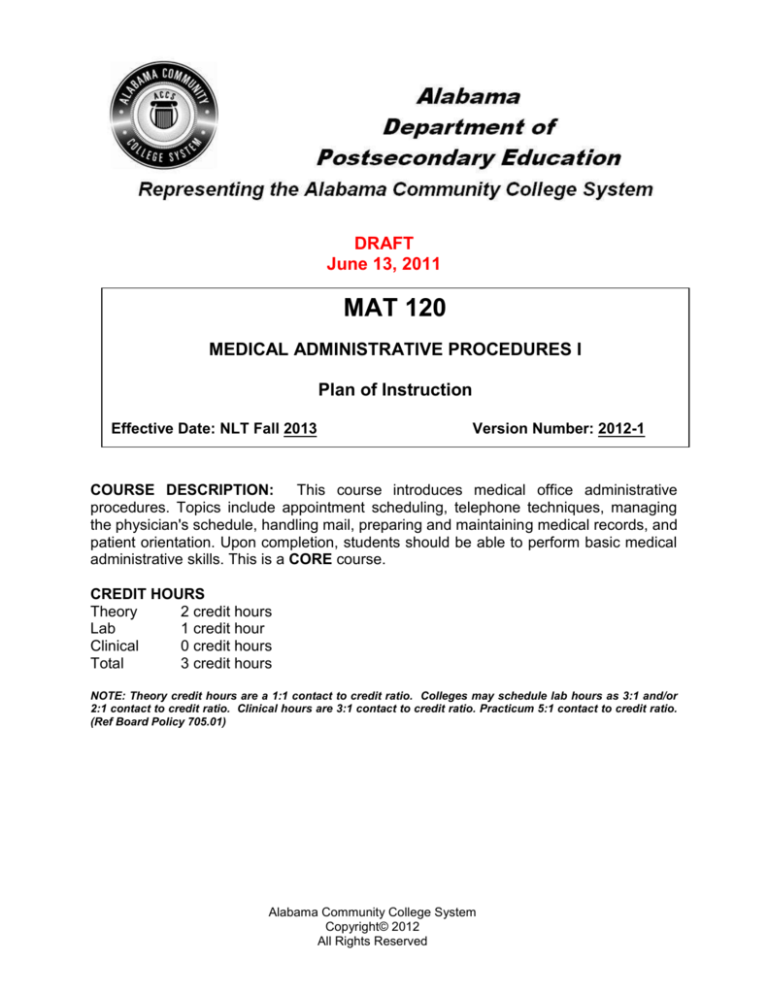
DRAFT
June 13, 2011
MAT 120
MEDICAL ADMINISTRATIVE PROCEDURES I
Plan of Instruction
Effective Date: NLT Fall 2013
Version Number: 2012-1
COURSE DESCRIPTION:
This course introduces medical office administrative
procedures. Topics include appointment scheduling, telephone techniques, managing
the physician's schedule, handling mail, preparing and maintaining medical records, and
patient orientation. Upon completion, students should be able to perform basic medical
administrative skills. This is a CORE course.
CREDIT HOURS
Theory
2 credit hours
Lab
1 credit hour
Clinical
0 credit hours
Total
3 credit hours
NOTE: Theory credit hours are a 1:1 contact to credit ratio. Colleges may schedule lab hours as 3:1 and/or
2:1 contact to credit ratio. Clinical hours are 3:1 contact to credit ratio. Practicum 5:1 contact to credit ratio.
(Ref Board Policy 705.01)
Alabama Community College System
Copyright© 2012
All Rights Reserved
Medical Administrative Procedures I
MAT 120
PREREQUISITE COURSES
None
CO-REQUISITE COURSES
None
INSTRUCTIONAL GOALS
Cognitive - Comprehend foundational knowledge of medical administrative
procedures.
Psychomotor - Apply foundational knowledge of medical administrative procedures.
Affective – Value the importance of complying with regulations and policies related
to medical administrative procedures.
PROFESSIONAL COMPETENCIES
Comprehend responsibilities of medical assisting professionals.
Comprehend proper telephone use and etiquette.
Demonstrate abilities to schedule and manage various types of appointment.
Demonstrate proper filing procedures.
Construct and manage medical records.
Handle and manage various types of mail.
PROFESSIONAL COMPETENCIES/OBJECTIVES
Unless otherwise indicated, evaluation of student’s attainment objectives is based on
knowledge and skills gained from this course. Competencies specified for each module
may be set by certification agencies, national and state codes, health care facility
policies, locally developed lab/clinical assignments, or any combination. Students are
expected to utilize relevant technology for client care and documentation. This course
is based on current national credentialing bodies.
ACCS Copyright© 2012
All Rights Reserved
2
Medical Administrative Procedures I
MAT 120
STUDENT LEARNING OUTCOMES
MODULE A - FRONT OFFICE RESPONSIBILITIES
PROFESSIONAL COMPETENCIES
A1.0
Comprehend responsibilities of
medical assisting professionals.
PERFORMANCE OBJECTIVES
A1.1 Given a simulated office
environment perform the duties
associated with opening,
processing, and closing the
office.
SAMPLES OF BEHAVIOR:
Preparing patient records
Accessing and storing records
Triage
Patient registration
Closing procedures
LEARNING OBJECTIVES
1.1.1
Discuss the various procedures and actions involved in opening and closing
a medical office.
1.1.2
Describe how to prepare records for the health care team members.
1.1.3
Describe various responsibilities for processing patients.
1.1.4
Summarize considerations for determining priority of patient care.
MODULE A OUTLINE
Opening and closing the medical office
Preparing records
Retrieving messages
Greeting patients
Processing patients
Triage
Patient registration
Privacy notice
Patient instruction form
ACCS Copyright© 2012
All Rights Reserved
KSA
Indicators
3
3
2
2
2
3
Medical Administrative Procedures I
MAT 120
MODULE B - TELEPHONE
PROFESSIONAL COMPETENCIES
B1.0
PERFORMANCE OBJECTIVES
Comprehend proper telephone use B1.1 This module is measured
and etiquette.
cognitively.
LEARNING OBJECTIVES
B1.1.1 Describe proper etiquette for telephone use.
B1.1.2 Discuss considerations for telephone policies and procedures commonly
used in medical offices.
MODULE B OUTLINE
Telephone policies and procedures
Answering incoming telephone calls
Placing outgoing calls
Telephone screening and triage
Telephone messages
Answering services
Voice mail
Answering Machine
Automated attendant
ACCS Copyright© 2012
All Rights Reserved
KSA
Indicators
2
2
2
4
Medical Administrative Procedures I
MAT 120
MODULE C - APPOINTMENTS
PROFESSIONAL COMPETENCIES
C1.0
Demonstrate abilities to schedule
and manage various types of
appointment.
PERFORMANCE OBJECTIVES
C1.1 Given a simulated medical office
environment schedule and
manage various types of
appointments.
SAMPLE S OF BEHAVIOR:
Scheduling various types of appointments
Managing appointments
Managing patient load
Scheduling tests
Changes and cancelations
LEARNING OBJECTIVES
C1.1.1 Describe various types of scheduling systems.
C1.1.2 Discuss the effectiveness of various scheduling systems.
C1.1.3 Describe how to schedule various types of appointments to ensure efficient
and effective patient load management.
MODULE C OUTLINE
Types of scheduling systems
Stream
Clustered
Double book
Patient per hour load
Open hours
Practice management software
Scheduling different types of appointments
Follow-up
Routine telephone appointments
Emergency situations
Referral appointments
Surgery scheduling
Outpatient diagnostic testing
Therapeutic testing
Other
ACCS Copyright© 2012
All Rights Reserved
KSA
Indicators
3
2
3
3
5
Medical Administrative Procedures I
MAT 120
MODULE D - FILING
PROFESSIONAL COMPETENCIES
D1.0
Demonstrate proper filing
procedures.
PERFORMANCE OBJECTIVES
D1.1 Given various types of patient filing
systems, apply protocols to file,
manage, and access patient records.
Samples of Behavior
Attention to detail
Accuracy
HIPAA compliance
Record filing
Record management
Record accessing
LEARNING OBJECTIVES
D1.1.1 List the characteristics of various filing systems.
D1.1.2 Differentiate between the various types of filing systems.
D1.1.3 Discuss alphabetic filing rules.
D1.1.4 Describe how to use various types of equipment and supplies used for filing
patient records.
D1.1.5 Describe how to use charge out and control systems.
D1.1.6 Describe how to manage various types of patient records.
MODULE D OUTLINE
Types of filing systems
Alphabetic
Numeric
Subject
Alphabetic filing rules
Filing equipment
Lateral files
Full-suspension drawer files
Automated files
Filing supplies and their uses
Guides
Folders
Color-coding file folders
Tabs
Labels
Charge out and control systems
Outguide
Outfolder
Managing records
Record retention and storage
Transfer
Financial and legal records
Active and inactive patient files
Electronic storage
ACCS Copyright© 2012
All Rights Reserved
KSA
Indicators
3
1
2
2
2
2
3
6
Medical Administrative Procedures I
MAT 120
MODULE E - MEDICAL RECORDS
PROFESSIONAL COMPETENCIES
E1.0
Construct and manage medical
records.
PERFORMANCE OBJECTIVES
E1.1 Given various scenarios and
simulations and patient records
content, construct and manage
patient records.
Samples of Behavior
Attention to detail
Accuracy
HIPAA compliance
Record construction
Record management and accessing
LEARNING OBJECTIVES
E1.1.1 Define terms associated with patient records.
E1.1.2 List content commonly found and its location in the patient records.
E1.1.3 Summarize the process of preparing and maintaining patient records.
MODULE E OUTLINE
Documentation terminology
Contents of patient’s medical record
Administrative
o HIPAA/confidentiality
o Insurance
o Emergency contact
o Other
Clinical
o Progress notes
o Medication records
Diagnostic
Therapeutic
History
Laboratory
Records management
Prepare and maintain medical records
Abstracting information from medical records
Correcting information in medical record
ACCS Copyright© 2012
All Rights Reserved
KSA
Indicators
3
1
2
3
7
Medical Administrative Procedures I
MAT 120
MODULE F - MAIL
PROFESSIONAL COMPETENCIES
F1.0
Handle and manage various types
of mail.
PERFORMANCE OBJECTIVES
F1.1 Given various scenarios involving
incoming and outgoing mail in
various formats, receive, sort,
and distribute the mail according
to medical office policies.
LEARNING OBJECTIVES
F1.1.1 Describe the importance of properly handling various types of mail.
F1.1.2 Discuss procedures for processing various types of incoming and outgoing
mail.
F1.1.3 Describe the types and uses of various forms of electronic messaging.
F1.1.4 Discuss the advantages and consequences of communicating with
electronic media.
MODULE F OUTLINE
KSA
Indicators
3
2
2
2
3
Processing mail
Incoming mail
o Mail security
o Opening mail
o Annotating mail
o Handling mail when physician is away
o Hand-delivered mail
Outgoing mail
o Mail classifications
o Special services
o Private delivery services
Electronic messaging and communication
Legal considerations
E-mail usage and etiquette
Netiquette
o Internet
o Social networking sites
o Messaging
Basic guidelines for using electronic messages and communication
Facsimile (Fax) communication
o Etiquette
o Operating guidelines
o Confidential records
ACCS Copyright© 2012
All Rights Reserved
8
Medical Administrative Procedures I
MAT 120
LEARNING OUTCOMES TABLE OF SPECIFICATIONS
The table below identifies the percentage of learning objectives for each module. Instructors should
develop sufficient numbers of test items at the appropriate level of evaluation.
Limited Knowledge
and Proficiency
KSA
Module A
Module B
Module C
Module D
Module E
Module F
1
0
0
0
17%
33%
0
Indicator
Key Terms
1
Limited
Knowledge
and
Proficiency
2
Moderate
Knowledge
and
Proficiency
3
Advanced
Knowledge
and
Proficiency
4
Superior
Knowledge
and
Proficiency
A
Affective
Objective
ACCS Copyright© 2012
All Rights Reserved
Moderate
Knowledge and
Proficiency
2
75%
100%
33%
66%
33%
75%
Advanced
Knowledge and
Proficiency
3
25%
0
67%
17%
34%
25%
Superior
Knowledge and
Proficiency
4
0
0
0
0
0
0
Learner’s Knowledge, Skills and Abilities
Description
Recognize basic information about the subject including terms and
nomenclature.
Students must demonstrate ability to recall information such as facts,
terminology or rules related to information previously taught.
Performs simple parts of the competency. Student requires close
supervision when performing the competency.
Distinguish relationships between general principles and facts. Adopts
prescribed methodologies and concepts.
Students must demonstrate understanding of multiple facts and
principles and their relationships, and differentiate between elements
of information. Students state ideal sequence for performing task.
Performs most parts of the competency with instructor assistance as
appropriate.
Examines conditions, findings, or other relevant data to select an
appropriate response.
The ability to determine why and when a particular response is
appropriate and predict anticipated outcomes.
Students demonstrate their ability to seek additional information and
incorporate new findings into the conclusion and justify their answers.
Able and willing to perform tasks independently..
Assessing conditions, findings, data, and relevant theory to formulate
appropriate responses and develop procedures for situation resolution.
Involves higher levels of cognitive reasoning.
Requires students to formulate connections between relevant ideas
and observations.
Students apply judgments to the value of alternatives and select the
most appropriate response.
Can instruct others how to do the competency.
Performs competency quickly and accurately.
Describes learning objectives that emphasize a feeling tone, an
emotion, or a degree of acceptance or rejection.
Objectives vary from simple attention to selected phenomena to
complex but internally consistent qualities of character and conscience.
Expressed as interests, attitudes, appreciations, values, and emotional
sets or biases.
9
Medical Administrative Procedures I
MAT 120
Northeast Alabama Community College
Evaluation of Learning Outcomes for Career/Technical Courses
Student Learning Outcomes Form 1
Faculty regularly review the extent to which the course and program learning outcomes identified in a
course syllabus are being attained by students who complete the course. Each syllabus identifies the
assessment method that will be used to demonstrate student mastery of the desired learning outcomes
for that course. Before teaching a course, faculty should review the syllabus to understand how the
learning outcomes will be evaluated. Once the course is complete, this form is used by the instructor to
report how well students demonstrated mastery of those course learning (and by extension, program
learning) outcomes.
Course Prefix & No.: MAT 120
Instructor:
Semester:
Type of Delivery – Mark One*:
Course Title: Medical Administrative Procedures I
Date:
Section Number(s):
Dual Enrollment
Online
Traditional
*Double click on the appropriate box. When the form field menu appears, select “checked” under Default value.
Note: To insert or delete rows on the table, click on Table on the tool bar.
Learning Outcome
Evaluation Method
Evaluation Results
(Industry or Professional
Competency)
Explain how each learning outcome for this course is
assessed.
Of the students who earned a grade
of C or better for the course, what
percentage demonstrated attainment
of the stated outcomes?
Comprehend
responsibilities of
medical assisting
professionals.
Comprehend
proper telephone
use and etiquette.
The student will demonstrate
comprehension of medical assisting
responsibilities by scoring at least
80% on selected test items.
The student will demonstrate
comprehension of proper telephone
use and etiquette by scoring at least
80% on selected test items.
The student will demonstrate the
ability to manage appointments and
schedules by scoring at least 80%
on a designated assignment.
Demonstrate
abilities to
schedule and
manage various
types of
appointment.
Demonstrate
proper filing
procedures.
Construct and
manage medical
records.
Handle and
manage various
types of mail.
The student will demonstrate proper
filing procedures by scoring at least
80% on a designated assignment.
The student will demonstrate the
ability to construct and manage
medical records by scoring at least
80% on a designated assignment.
The student will demonstrate the
ability to handle and manage various
types of mail by scoring at least 80%
on a designated assignment.
Use of Evaluation Results
ACCS Copyright© 2012
All Rights Reserved
10
Medical Administrative Procedures I
MAT 120
Explain how evaluation results will be used to improve the course.
*Reviewed:
Division Director or Program Supervisor
Date
*To be completed by Division Director or Program Supervisor Only
ACCS Copyright© 2012
All Rights Reserved
11



